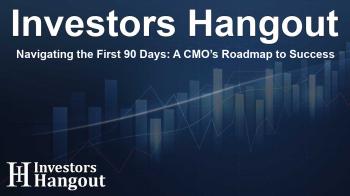Navigating the First 90 Days: A CMO’s Roadmap to Success

Transitioning Successfully into a CMO Role
The journey of a Chief Marketing Officer (CMO) is not just challenging; it's a pivotal moment in one’s career, filled with opportunities for significant impact. Info-Tech Research Group has launched a comprehensive guide designed to equip new marketing leaders with the insights needed to thrive. This strategic resource aims to help CMOs build a strong footing in their roles, focusing on immediate wins that pave the way for long-term success.
Understanding the CMO's Landscape
Marketing leaders, often under intense pressure, must navigate a landscape rife with expectations. The reality of the role is that the average tenure for CMOs hovers around four years, showcasing both the high expectations and the fast-paced nature of this position. This necessitates a multi-faceted approach to quickly identify opportunities, foster stakeholder relationships, and align marketing initiatives with broader business objectives.
Recognizing the Challenges
As outlined in the resource, CMOs frequently confront several obstacles that can undermine their efficacy. Key challenges include insufficient alignment with overarching business strategies, ineffective collaboration across teams, and perceived credibility issues with other executives. Attention to these factors is vital in establishing a lasting presence within the organization.
Embracing Data-Driven Decision-Making
A crucial area often overlooked is the need for robust data analysis capabilities. Effective decision-making requires access to meaningful data insights, which empowers CMOs to measure marketing impacts accurately. Understanding organizational needs in this regard is foundational for success. CMOs are encouraged to enhance their data literacy to advance both immediate results and strategic objectives.
A Structured Approach to Transition
Info-Tech’s framework details a clear 90-day action plan designed for effective onboarding. This phased strategy emphasizes a gradual yet thorough approach to securing future success:
1. Setting the Stage (Days 1–30)
The initial phase focuses on gaining a deep understanding of the market environment and business dynamics. This involves analyzing internal perceptions, assessing competitor strategies, and conducting a comprehensive strategic evaluation.
2. Establishing Strategic Direction (Days 31–60)
Once the groundwork is laid, CMOs should develop a robust strategic framework. This includes articulating a compelling marketing vision, setting clear goals, and designing a comprehensive plan that aligns marketing efforts with prevalent business launch priorities.
3. Execution of the Strategy (Days 61–90)
In the final phase, CMOs should identify key strategic initiatives, allocate necessary resources, and establish a timeline for successful implementation. This stage is essential for evaluating risks and understanding team capabilities to ensure smooth execution.
Balancing Quick Wins and Sustainable Growth
Navigating the pressures inherent in the CMO role requires a balance between achieving quick wins and developing long-term strategies. It's vital for marketing leaders to establish credibility while laying down the groundwork for enduring market presence.
Conclusion: The Path Ahead for CMOs
As CMOs embark on their journey, understanding the nuances of their role is critical. The guide by Info-Tech Research Group provides a clear pathway to help navigate the complexities of their positions. With a thoughtful approach that prioritizes both immediate results and strategic development, CMOs can not only meet expectations but also exceed them, positioning themselves and their organizations for lasting success.
Frequently Asked Questions
What is the primary objective of the Info-Tech guide for CMOs?
The guide aims to provide CMOs with a structured approach to achieve early wins while laying the foundation for long-term success in their roles.
How long should CMOs take to adapt to their new role according to the guide?
The guide outlines a structured 90-day onboarding framework to facilitate smooth transitions for CMOs.
What are some common barriers CMOs face?
Common barriers include misalignment with business strategies, poor cross-departmental collaboration, and lack of trust with executive leadership.
Why is data analysis critical for a CMO?
Data analysis supports strategic decision-making and helps CMOs develop insights that inform marketing strategies and campaign effectiveness.
What is the significance of quick wins in the CMO role?
Quick wins help establish credibility and demonstrate value, but they should not compromise long-term strategic goals and sustainability.
About The Author
Contact Hannah Lewis privately here. Or send an email with ATTN: Hannah Lewis as the subject to contact@investorshangout.com.
About Investors Hangout
Investors Hangout is a leading online stock forum for financial discussion and learning, offering a wide range of free tools and resources. It draws in traders of all levels, who exchange market knowledge, investigate trading tactics, and keep an eye on industry developments in real time. Featuring financial articles, stock message boards, quotes, charts, company profiles, and live news updates. Through cooperative learning and a wealth of informational resources, it helps users from novices creating their first portfolios to experts honing their techniques. Join Investors Hangout today: https://investorshangout.com/
The content of this article is based on factual, publicly available information and does not represent legal, financial, or investment advice. Investors Hangout does not offer financial advice, and the author is not a licensed financial advisor. Consult a qualified advisor before making any financial or investment decisions based on this article. This article should not be considered advice to purchase, sell, or hold any securities or other investments. If any of the material provided here is inaccurate, please contact us for corrections.

